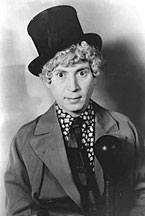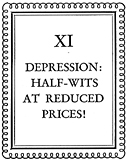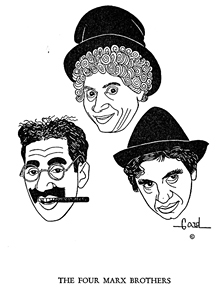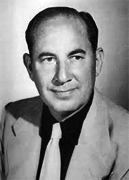 One of the first places we went upon receiving our driver’s license (and the mobility that came with it) some—gulp!—36 years ago was the miniscule (and long since defunct) Mini-Mall Theatre in north Oklahoma City. They featured old movies there, mostly comedies, and we wanted to see a Marx Brothers movie. We had become intrigued somehow with the Marxes—Groucho, especially—but had never seen one of their pictures.
One of the first places we went upon receiving our driver’s license (and the mobility that came with it) some—gulp!—36 years ago was the miniscule (and long since defunct) Mini-Mall Theatre in north Oklahoma City. They featured old movies there, mostly comedies, and we wanted to see a Marx Brothers movie. We had become intrigued somehow with the Marxes—Groucho, especially—but had never seen one of their pictures.
The bill that evening was Horse Feathers (1932), followed by Duck Soup (1933). As Horse Feathers opens, Groucho is being inducted as President of Huxley College. Following his introduction by the outgoing president, Groucho begins his speech this way:
“Members of the faculty and faculty members, students of Huxley and Huxley students—I guess that covers everyone. I thought my razor was dull until I heard his speech, and that reminds me of a story that’s so dirty I’m ashamed to think of it myself. I came to this college for one reason: to get my son out of it. I remember the day he left for school, a mere boy and a beardless youth. I kissed them both goodbye.”
Groucho was off and running, and so were we. From that night on, we couldn’t get enough of Groucho, Harpo, Chico, and sometimes Zeppo. The Marxes quickly became our avocation, and an avid one at that. We were initially drawn most strongly to Groucho, who was cracking the jokes we would had made if we were clever enough.
But we also loved Chico’s puns and crazy piano stylings and, even more, Harpo’s innocently mischievous ways. Over the years, our affection for Groucho has not faded, but we’ve grown ever fonder of Harpo. Our appreciation for the second eldest Marx may have been fueled by our increasing knowledge of—and appreciation for—the great silent comics such as Buster Keaton, Harold Lloyd, and Charlie Chaplin. We’re convinced that, had Harpo not been part of a family act that very much relied on dialogue and wordplay, he could have been right up there with those comic greats in the silent era.
By all reports, it wasn’t hard to love Harpo. Everything we’ve read (and we’ve read just about everything there is to read on the Marxes) suggests that he was as lovely a fellow as you’d ever want to meet, kind and gentle and fun-loving (the term that so often gets used to describe him is “childlike”).
Harpo’s autobiography, Harpo Speaks!, is still (or, perhaps, again) in print, and we highly recommend it to you. We have enjoyed it more every time we’ve read it, and Ms. Cladrite, who has to date viewed only a couple of Marx Brothers movies, found it an engaging and charming read.
But we also want to recommend a delightful web site of which a pal made us aware recently. It’s called Harpo’s Place, and is described on the home page as The Official Arthur Harpo Marx Family Online Collection. It’s a lovingly crafted tribute to Harpo—the man, the actor, and the father—and it has no other agenda than to celebrate and commemmorate his life and career. There’s nothing for sale on the site (heck, we almost wish there were), and it’s loaded with material even the most devoted Marxist might never have seen before. Harpo’s Place is clearly a labor of love, and that labor has paid off in a delightful site that we heartily recommend to you.
Check it out, and tell ’em Cladrite Radio sent you.






